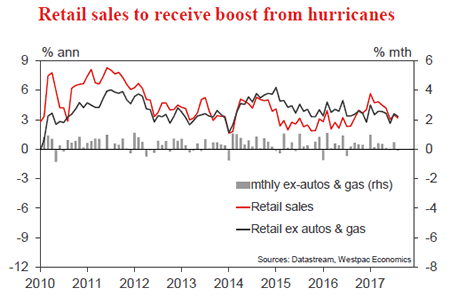Week beginning 9 October 2017
- Business investment lifts, but recovery uneven and upside constrained.
- Australia: Westpac-MI Consumer Sentiment, NAB business survey, housing finance.
- RBA: Financial Stability Review, Deputy Governor speaking.
- NZ: card spending, house prices and sales.
- China: aggregate financing, Caixin services PMI.
- Euro Area: industrial production.
- US: FOMC meeting minutes, retail sales, CPI.
- Key economic & financial forecasts.
Information contained in this report was current as at 6 October 2017.
Business Investment Lifts, But Recovery Uneven and Upside Constrained
Reserve Bank of Australia Governor Philip Lowe struck a positive tone on business investment in the Statement accompanying the RBA’s policy decision on October 3. He stated that: "Over recent months there have been more consistent signs that non-mining business investment is picking up. A consolidation of this trend would be a welcome development." Here we consider the case for increased optimism on business investment and assess the outlook.
Business investment by the non-mining sectors strengthened over the past year. Annual growth lifted to 4.6% in mid-2017, we estimate, a pace approaching the historic average of 4.9%. That is a marked improvement on a 1.0% outcome in mid-2016 and is the best result since 2011 to 2012, when growth averaged 7.5%. That said, the current pace falls well short of the sustained strength evident during the six years 2002 to 2007, when nonmining investment grew by a brisk 12% a year on average.
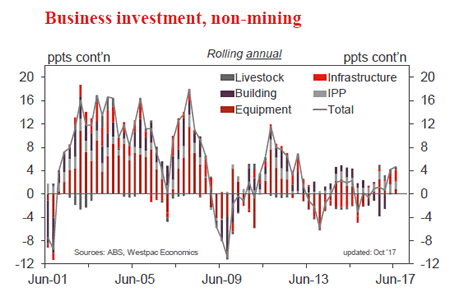
In assessing trends in business investment we will largely focus on spending by asset class. This spans equipment spending (which accounts for 40% of the total); non-residential building (a 25% weight); intellectual property products, including computer software (a 20% weight); infrastructure (a little in excess of 10%) and livestock.
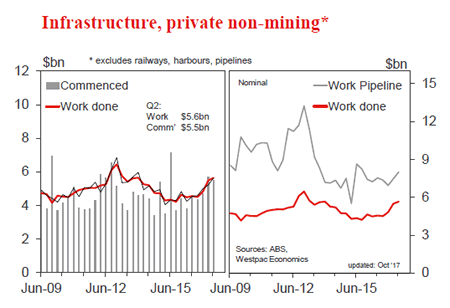
Growth in business investment to date has been uneven. Nonbuilding activity was flat over the past year, while equipment spending grew at a sub-par pace, up 2.0%, relative to a longrun average of 6%. Strength has been concentrated in the smaller asset class of infrastructure activity, accounting for almost 2ppts of the 4.6% rise in total investment. Computer software spending is advancing at a solid clip, albeit below its long run average, accounting for 1.4ppts of the rise in investment. Livestock, which typically has a neutral impact, added 0.6ppts, as some herd rebuilding occurs.
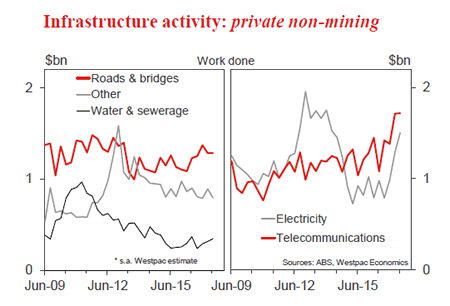
The uneven nature of the uptrend in business investment may prove to be a temporary feature, ahead of an emerging more broadly based upswing. Alternatively, it may be symptomatic of more general uneven economic conditions, a view that we favour, as explored below.
Infrastructure activity has been the stand-out performer recently. Private non-mining infrastructure work rebounded by 19% in the year to June 2017, partially reversing a sharp fall over the two years to mid-2015, which was followed by a flat period to mid-2016. The lift in activity is fully centred on two segments, namely: telecommunications, with some long overdue upgrading of the network; and electricity generation, with the nation facing potential power shortages. Outside of these two areas, activity is broadly flat, including segments such as roads; water & sewerage; and recreation. Near-term, prospects are for some further upside, but for growth to moderate, with the level of work done currently in line with the value of commencements.
Spending on intellectual property products (IPP), which includes R&D as well as computer software, is expanding at a solid clip. The segment notched up 7% growth over the past year, although that is still short of the long-run average of 9.5%. Businesses are focused on enhancing their technology, with a view to innovation and increased productivity. This is a mediumterm theme and the pace of growth in total IPP spending has been steady since 2014, with no sign of acceleration.
Non-residential building is at a turning point, with the prospect of a near-term lift in activity, a point that we have highlighted previously. Private approvals for the 12 months to August are 18% above that for the previous year, although we would discount this somewhat due to some slippage in pass through to commencements. Consistent with the approvals data, the latest update from the ABS capex survey included an upgrading of 2017/18 investment plans of the service sector.
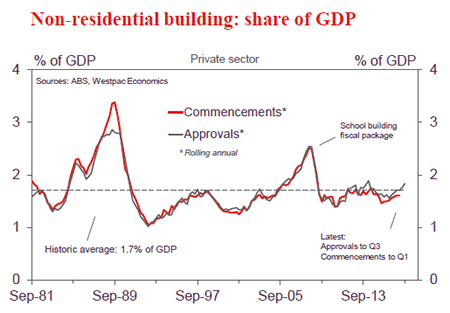
The capex survey, which provides only a partial coverage of total business investment, points to a increase in service sector capex spending in the order of 10%, centred entirely on building & structures, with equipment flat.
In the building sector, more projects have received the go ahead in retail, social building (including education, health and accommodation), and particularly offices, with approvals up 75% for this segment, to be back at historic highs. This is to meet the needs of a growing population, as well as to service rapid growth in both international tourism and foreign student numbers. Having said that, in the post GFC period, there is no sense that the sector is set for a sustained strong upswing, with the absence of a speculative dynamic. Rather, the latest round of projects will satiate current demand, following which activity will likely either consolidate or dip temporarily.
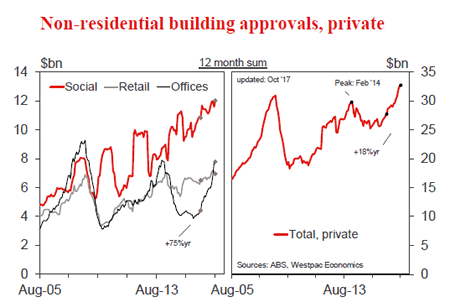
Equipment spending, 40% of non-mining business investment, has been underwhelming. Growth was a sluggish 2% over the past year, coming on the heels of a 1% rise the year prior. There are some bright spots. The manufacturing sector reports that agriculture and some parts of mining have lifted equipment spending of late, on the back of stronger income growth associated with higher commodity prices. However, a key driver of equipment spending is the need for businesses to expand capacity to meet rising demand from the household sector. It is this driver that is underperforming. The RBA Governor made reference to this point in his Statement of October 3, "Against this, slow growth in real wages and high levels of household debt are likely to constrain growth in household spending".
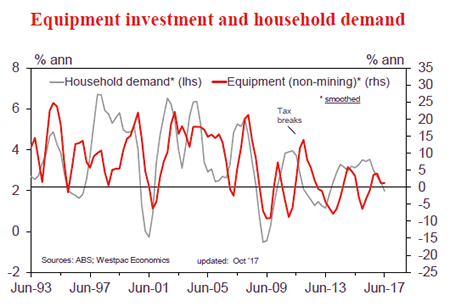
Competing views on the outlook for the household sector are critical to prospects for a broadening and acceleration in the uptrend in non-mining business investment. On this matter, the Westpac Economics’ view differs from that of the official family.
We expect consumer spending growth to be stuck at a lacklustre 2.5% annual pace, associated with persistent weakness in wages growth. In addition, we expect home building activity to weaken materially in 2018, led by a correction in the high-rise segment. By way of contrast, the forecasts in the May Federal Budget are more optimistic for 2018/19, expecting: consumer spending growth to lift to 3.0%, associated with a 3.0% increase in wages and a solid 1.5% rise in employment; and home building activity to decline relatively gradually, -4% vs Westpac at -7%. If household demand growth plays out as we expect in 2018 then the risk is that equipment spending remains relatively lacklustre.
In summary, business investment by the non-mining sectors has emerged from the softness apparent for much of the post GFC period. There is a need to add to the capital stock to meet the needs of a relatively fast growing population. Moreover, the negative spill-overs from the mining investment downturn have faded and world growth has improved. On balance, we see non-mining business investment growth continuing at around the current 4½% pace, supported near-term by the emerging lift in non-residential building activity.
However, we also expect the investment recovery to be uneven, reflective of the uneven nature of the broader economic expansion, with the household sector the key source of weakness. Equipment spending, which represents 40% of total investment by the non-mining sectors, will remain relatively subdued in this environment. If so, it is unlikely that the non-mining business investment cycle surprises materially to the upside, diminishing the prospect of the economy accelerating to a sustained above trend growth path. Our point forecast for December 2018, is total non-mining business investment growth of 5.0%yr, with equipment broadly flat.
The Week that Was
This week, we have been firmly focused on Australia and the outlook for the RBA.
The statement released by the RBA following its October meeting carried a number of subtle but interesting changes. Foremost was the shift in language around non-mining investment – see the essay above for further detail. Attention shifted from the outlook (which was characterised as having "improved recently" in September) to current experience, given "consistent signs that non-mining business investment is picking up". Further, the "large pipeline of infrastructure investment" that we have often discussed was also noted. This is best interpreted as the RBA gaining confidence in their expectation of improving business investment into 2018. Still, a constrained household sector continues to bother the RBA, the statement noting that "slow growth in real wages and high levels of household debt are likely to constrain growth in household spending". Though the Australian dollar has fallen from around USD0.80 to USD0.78 since the September meeting, the commentary on the currency ("weighing on the outlook for output and employment") was left unchanged. On the outlook for activity therefore, there is still a high degree of uncertainty, all the more so given this week’s data outcomes.
The other key point to note regarding monetary policy is the RBA’s clear concern over household debt, particularly that it continues to grow at a multiple of income growth. This has been a key theme in recent speeches by RBA staff, and in the October statement, it received greater prominence, coming ahead of the current conditions discussion in the housing paragraph. As we emphasise, it remains our view that the RBA and APRA will continue to target the household debt issue with macroprudential policies rather than rates. Nonetheless, this remains an important theme to track.
On to this week’s Australian data. All three key releases spoke to our concerns regarding the outlook, most notably retail sales.
For the month of August, retail sales fell 0.6% against the market’s expectation of a 0.3% rise. See the chart of the week box for further detail. This outcome pairs very well with the ‘family finance’ and ‘time to buy detail’ from our Westpac-MI Consumer Sentiment survey (an update will be received next week), with each of these measures consistently printing at below average levels through 2017. Combined with our expectation that wage gains will remain subdued versus history, this is a key reason as to why we believe that the RBA’s expectations regarding the consumer will be disappointed in 2018.
Also informing on a component of household demand, the dwelling approvals release for August was broadly in line with expectations, but more importantly continued to suggest that residential investment will be a negative for growth in 2018 (versus the RBA’s expectation that it will be broadly neutral). High-rise approvals, having fallen 50% over the past year, are expected to fall further. Low-rise approvals (townhouses up to 4 stories) have pushed higher in recent months, but in August single-home approvals lost some of their recent momentum. Auction markets and house price measures are softening (to varying degrees) across the major cities, hence single-home and low-rise approvals should flatten out in coming months. Given the substantial tightening in restrictions around foreign buyers and developers, the risks to the outlook for residential construction are likely skewed to the downside.
Finally on trade, here we received another surprise in August, this time to the upside as exports increased while imports stalled. On exports, iron ore was the big positive, up on higher prices, against which there were declines in coal, gold and base metals. The bigger point though is that for the September quarter as a whole, the trade data is not as constructive for growth as we had hoped. Hence the positive contribution we have pencilled in from net exports for GDP may not come to pass. Currently the data imply a nil contribution from net exports in Q3.
On the international scene, at the beginning of the week, we received a positive update on China, with both official PMIs rising to multi-year highs. Despite strength in production and new orders, employment remains a concern. Elsewhere in Asia, Japan remained a stand out, while India and Indonesia continued to experience more moderate expansions amid considerable uncertainty. Broadly, these updates continue to suggest that the global uptrend in trade is likely to persist, albeit with growth slowing over the coming year.
Also, for those with an interest in Europe, a quiet week has seen us take stock of the state of the Continent’s consumer and the likely outlook for household demand.
Chart of the week: retail sales
For the month of August, retail sales fell 0.6% against the market’s expectation of a 0.3% rise. Further, July’s flat result was revised lower to a 0.2% fall. The combined July/August result is the weakest two month period since October 2010 (which came near the end of the RBA’s 2009-10 tightening cycle) and leaves annual growth at 2.1%yr, its weakest result since June 2013. The detail of the report highlighted that the weakness in sales was broad based across subsectors and states.
While monthly retail sales are a nominal measure, and thus can be weighed down by price discounting, we doubt that underlying retail volume growth will be robust. This in turn points to significant downside risks to the Q3 consumption estimates in the national accounts and wider GDP growth.
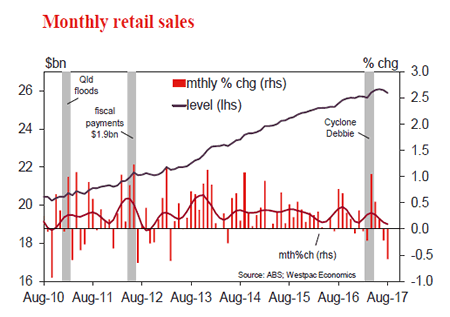
New Zealand: Week ahead & Data Wrap
More of the same
The latest Quarterly Survey of Business Opinion indicates that election uncertainty may have weighed on sentiment about the broader environment, but firms remain content about their own prospects. The survey suggests that the New Zealand economy is on track to continue to grow at a modest pace, but that the June quarter is likely to have marked the peak for growth this year.
General business sentiment fell from a net 17% positive to a net 7% in the September survey. The survey was conducted over the September month, so as we’ve seen with other measures such as our consumer and regional confidence surveys, uncertainty about the outcome of the 23 September general election may have weighed on respondents’ minds.
In contrast, firms showed fewer concerns about their own performance. A net 13% of firms reported improved conditions over the last quarter, compared to a net 17% in June. Meanwhile, expectations for the quarter ahead picked up a little compared to the last survey, and have been fairly consistent over the past year.
The detailed survey questions painted a similarly positive picture. Reported hiring over the last quarter rose to an equal-record high, and intentions for the next quarter were also high. Investment intentions were steady for plant and equipment, and up sharply for buildings. Profits were reported as broadly flat over the last quarter, but were expected to pick up.
There was some variation in fortunes across sectors. Retailers and manufacturers were generally more positive over the quarter, while the building and services sectors saw a drop in confidence. Notably, 41% of firms in the building sector reported that labour is their biggest constraint on growth, compared to 32% who cited lack of demand.
In recent times we’ve discussed the slowdown in construction activity, including the extent to which it has been the result of tighter financing conditions affecting demand, supply-side constraints such as skill shortages, and/or other factors. The results of this survey suggest that – in the commercial property space at least – demand remains strong, and capacity constraints seem to be the greater factor.
The QSBO also provides an array of information about capacity constraints and price pressures. The indicators from the September quarter survey were mixed. On the stronger side, the difficulty of finding workers rose to its highest level since 2007. Capacity utilisation fell slightly for a second quarter, but it remains at one of the highest levels on record.
However, these apparent capacity pressures haven’t translated to a similar lift in the rate of inflation. More firms are reporting cost increases, but this share has remained relatively low in the years since the Global Financial Crisis. Despite the capacity constraints that were evident elsewhere in this survey, fewer builders reported a rise in costs and prices this quarter.
Similarly, the share of firms reporting that they had raised their prices or intended to do so was unchanged in the September quarter. At their current levels, these measures are consistent with inflation near the Reserve Bank’s target midpoint of 2%, but they don’t suggest a risk of inflation breaking to the upside in the near term.
Consumer prices for the September quarter will be published later this month. We’re putting the final touches on our forecast, which currently stands at a 0.5% increase for the quarter. This would see the annual inflation rate lift from 1.7% to 1.9%. Our forecast is quite a bit higher than the Reserve Bank’s pick of 0.2% for the quarter (1.6% annual). However, most of the difference is in the tradables component – including volatile factors such as food and fuel prices, which the Reserve Bank has more scope to look through.
In general, the high-level indicators of economic activity, such as the QSBO and our quarterly confidence surveys, have been only a touch softer for the September quarter compared to June. That’s consistent with our view that the economy will continue to grow at a modest pace over the rest of this year, but that the 0.8% rise in June quarter GDP is likely to mark the high point for growth this year. The June quarter benefited from a range of temporary factors that won’t be repeated in the September quarter figures: a boost to tourism spending from two major sporting events, and a rebound from earlier disruptions in dairy production and rail transport.
In fact, dairy output is shaping up to be a drag on near-term GDP growth again. Wet weather has hampered pasture growth in the early part of this season, and milk collections to date are down on the previous season (which were already subdued, given the pressures generated by low milk prices at the time). Fonterra’s forecast of a 3% rise in milk collections for the season now looks like more of a stretch than it did at the start of the season.
All else equal, lower than expected volumes from New Zealand are often offset by higher world prices for dairy products – an idea that seemed to pervade the market ahead of this week’s GlobalDairyTrade auction. The surprise 2.4% fall in auction prices served as a reminder that supply is only one half of the story, and that the strength of world demand shouldn’t be taken for granted.
We have maintained our forecast of the farmgate milk price for this season at $6.50/kg, compared to Fonterra’s forecast of $6.75/ kg (with other forecasters sitting somewhere around that level). That said, the level of production and hence prices remains very sensitive to the weather over the next few months, as dairying enters its peak period.
For the week ahead, the economic highlights will include updates on the housing market and consumer spending during September – and most importantly, a potential resolution about the shape of the next Government. On Saturday the special vote count will be completed, and the final seat allocations announced. After that, the negotiations among the major political parties will be full speed ahead – NZ First leader Winston Peters has given a selfimposed deadline of 12 October for making a decision about who to align with.
Data Previews
Aus Oct Westpac-MI Consumer Sentiment
Oct 11 Last: 97.9
- The Westpac-Melbourne Institute Consumer Sentiment Index rose 2.5% to 97.9 in September from 95.5 in August. Despite the lift, pessimists continue to outnumber optimists with pressures on family finances, concerns around interest rates, deteriorating housing affordability, rising energy prices and weak wages growth offsetting any boost from improved jobs growth.
- This month’s survey is in the field over the week ended Oct 8. Factors that may influence confidence include: the RBA’s decision to again leave rates on hold at its Oct meeting; more signs of cooling across Australia’s major housing markets; and a disappointing retail update showing a surprise fall in sales. Both the AUD and ASX are down over the last month. Against this, jobs data has continued to perform strongly.
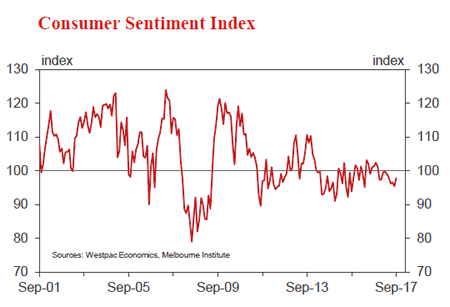
Aus Aug housing finance (no.)
Oct 12, Last: 2.9%, WBC f/c: flat
Mkt f/c: 0.5%, Range: -1.6% to 1.5%
- The number of housing finance approvals to owner occupiers posted another surprisingly strong gain in July up 2.9% and 4.5% ex refinancing. Note that the macro prudential tightening measures introduced in late March and associated increases in rates for investor and ‘interest only’ loans in March and June have likely given indirect support to owner occupier loan activity. Indeed, the value of investor loans fell 3.9% in July.
- The full impact of these shifts is still coming through. Industry data suggests owner occupier loans were again firm in August but with some signs that the recent lift is levelling out. We expect owner occupier approvals to be flat in the month. The focus will again be on investor loans and to a lesser extent construction-related finance which has shown a notable lift in recent months.
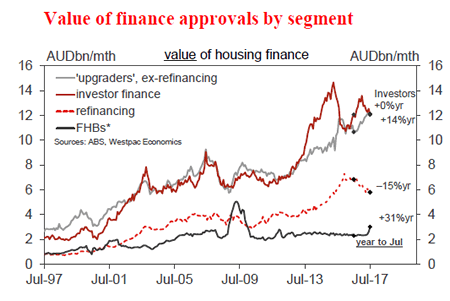
NZ Sep retail card spending
Oct 10, Last: -0.2%, Westpac f/c: 0.5%, Mkt: 0.5%
- Retail spending was softer than expected in August, with spending levels down 0.2%. That followed a fall of 0.6% in July.
- Spending levels have been broadly flat for several months now. In part, this is because of the softness in prices, particularly for imported consumer goods. However, it’s likely that the softening in the housing market is also dampening household spending, particularly for items such as household furnishings.
- Increases in fuel prices should push retail spending higher in September. However, with lingering softness in the housing market, and an easing in tourist arrivals following their surge earlier in the year, the underlying pace of spending looks set to remain modest.
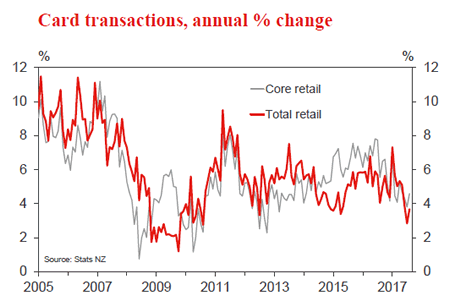
NZ Sep house prices and sales
Oct 9-13 (tbc), Sales last: +0.6%, Prices last: 0.5%yr
- New Zealand’s housing market has slowed substantially over the last year. House sales are down by a quarter, and sale prices have flattened out. Prices have fallen slightly in Auckland and Christchurch, while the rate of increase in the rest of the country has slowed.
- There was a tentative stabilisation in August, with sales and prices ticking up slightly. A sharp slowdown in the rate of new listings – property owners don’t sell into a weak market if they don’t have to – has helped to rebalance the market.
- Nevertheless, we think this improvement could be shortlived, as higher mortgage rates and lending restrictions remain the dominant factors. And to the extent that election uncertainty has been a factor recently, it will surely have weighed on the market again in September.
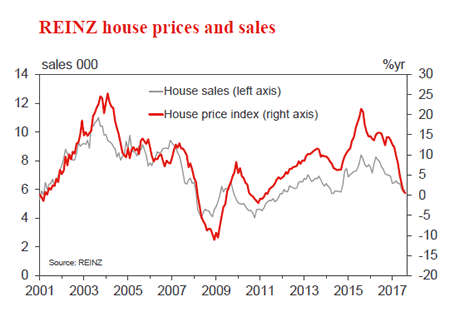
US Sep CPI
Oct 13, last: 0.4%, WBC: 0.5%
- Inflation has been an ongoing disappointment in the US in 2017, with core and headline CPI inflation having fallen back below the 2.0%yr medium-term target as the PCE measure remained there.
- However in August, headline prices rose 0.4% as gasoline prices jumped over 6% and rents also experienced a strong month. Annual headline inflation lifted from 1.7%yr to 1.9%yr.
- Come September, hurricane season will see gasoline run higher again and headline prices increase 0.5% overall. Annual inflation is therefore set to bounce back above 2.0%.
- These inflationary influences will prove transitory, so it is best to focus on core inflaton. This measure is expected to print a more modest 0.2%, 1.7%yr. Further out, expect to see headline and core inflation settle a little below the 2.0%yr medium-term target of the FOMC.
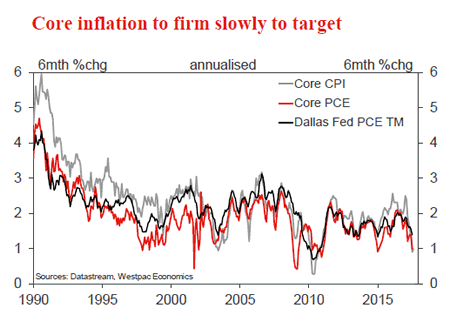
US Sep retail sales
Oct 13, last: -0.2%, WBC: 1.2%
- Aug was a soft month for US retail, in part because the arrival of hurricanes Irma and Harvey weighed heavily on car sales in affected regions. Nationwide sales were down 1.6% as a result. That said, given both headline and core retail sales fell 0.2% in the month, households also clearly stocked up ahead of the storm, offsetting some of the weakness.
- Come Sep, not only will there be a sharp reversal in car sales (Reuters has reported sales of new cars in the Houston area were up 109% in the three weeks after the storm versus the three weeks prior), but significant household spending will also need to take place to replenish household stocks and make necessary initial repairs to buildings. As a consequence, retail sales will jump in Sep.
- It is worth highlighting however the 0.2% fall in core sales in Aug and the downward revisions to Jul. These results imply that, sans weather, the US consumer remains reluctant to spend. This is a key reason why GDP growth is likely anchored to 2.0% despite job growth and sentiment.
